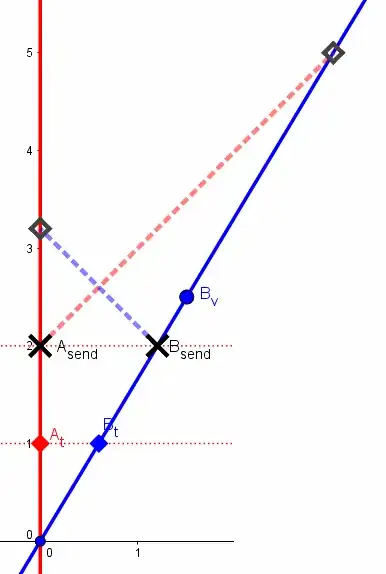But my question was: Does this symmetry REALLY exist DURING THE PERIOD OF UNIFORM MOTION? How can each clock be running slower than the other during this period?
The measuring procedure has some interesting details.
It is often said, that a single clock dilates relatively to a reference frame of observer, a.k.a rest frame.
Very often observer in special relativity is not a physical person, but the whole frame itself, or team of observers. Each of them possesses a clock and these clocks are Einstein - synchronized by beam of light. The beam of light travels from observer to observer and they adjust their clocks accordingly, since they know velocity of light c and distance the beam travels, so they can calculate how much time it took for the light to go from clock to clock.
https://en.wikipedia.org/wiki/Einstein_synchronisation
You can imagine Einstein - synchronized clock A,B,C,D... X,Y,Z These clock show the same time in reference frame K. All that reference frame K is an observer, or family of observers.
Single clock C1 moves in reference frame K. Then observer of reference frame K compares readings of clock A-Z with clock C1 in immediate vicinity, when clock C1 passes by these clocks.
https://en.wikipedia.org/wiki/Observer_(special_relativity)
If moving clock C1 and clock A showed 12 PM at meeting, moving clock will show 3 PM and clock Z will show 6 PM when they will meet. This is how time dilation works. SINGLE moving clock dilates relatively to a set of synchronized and spatially separated clocks, not vice versa. Set of clock runs faster from the point of view of single clock.
This article emphasizes this detail at page 6 (6)
http://isites.harvard.edu/fs/docs/icb.topic455971.files/l09.pdf
Animation:
https://en.wikipedia.org/wiki/Time_dilation#/media/File:Time_dilation02.gif
Related articles:
https://arxiv.org/ftp/physics/papers/0512/0512013.pdf
Good article that gives correct explanation:
http://www.pstcc.edu/departments/natural_behavioral_sciences/Web%20Physics/Chapter039.htm
"Two spatially separated clocks, A and B, record a greater time interval between two events than the proper time recorded by a single clock that moves from A to B and is present at both events."
If observer, who was once in motion wants to measure dilation of relatively moving clock, he has to turn himself into one "at rest" and introduce his own rest frame by means of putting two Einstein - synchronized clock at point of departure and arrival of single clock.
In your case your rest frame consist of two Einstein - synchronized clocks. One is on the Earth, another is on Planet X. Spaceship is the Single clock. You compare readings of clocks Earth with clock Spaceship first and clock Planet X with clock Spaceship 20 years later.
Spaceship can measure dilation of single clock Earth or of single clock Planet X. For example, he wants to measure dilation of clock Earth. Spaceship places two Einstein - synchronized clock at point of departure of the Earth and point of arrival of the Earth and compares readings of his synchronized clocks with clock Earth when these clocks are in immediate vicinity.
Good to note, that only observer "at rest" measures dilation of moving clock. To get reciprocal observations, we have to "forget" old frame and replace it with a new one, this way turning that observer who was once in motion into one "at rest".
If Single clock compares it's readings successively with clocks of rest frame, it will measure, that time in reference frame runs faster.
From the point of view of reference frame, single clock dilates. From the point of view of single clock, time in reference frame runs faster, since it's own "time" runs slower.
Mossbauer effect rotor time dilation test demonstrate that effect very well.
Is that what you were looking for?
If we don't change frames, the moving observer measures, that clock of observer "at rest" ticks gamma times faster, not slower that his own. For example, if moving observer measures frequency shift, he will detect blueshift of frequency, but not redshift, i.e. clock at rest runs gamma times faster.
https://en.wikipedia.org/wiki/Relativistic_Doppler_effect
The transverse Doppler effect is the nominal redshift or blueshift predicted by special relativity that occurs when the emitter and receiver are at the point of closest approach. Light emitted at closest approach in the source frame will be blueshifted at the receiver. Light received at closest approach in the receiver frame will be redshifted relative to its source frequency.
Reflection from a transversely moving mirror graphically demonstrates that. https://www.youtube.com/watch?v=FQKp3FU8vR8
P.S. I think there is a mistake in Wikipedia. Light emitted at closest approach is redshifted. Light received at closest approach is blueshifted.


